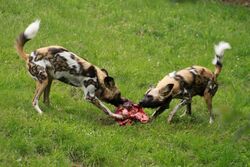Biology:Lycaon (genus)
| Lycaon | |
|---|---|

| |
| African wild dogs | |
| Scientific classification | |
| Domain: | Eukaryota |
| Kingdom: | Animalia |
| Phylum: | Chordata |
| Class: | Mammalia |
| Order: | Carnivora |
| Family: | Canidae |
| Subfamily: | Caninae |
| Tribe: | Canini |
| Genus: | Lycaon Brookes, 1827 |
| Species | |
| |
Lycaon is a genus of canid which includes the African wild dog (Lycaon pictus) and the extinct species Lycaon sekowei and Lycaon magnus.
Taxonomy
This hypercarnivorous and highly cursorial genus is distinguished by accessory cusps on the premolars. It branched from the wolflike canids lineage during the Plio-Pleistocene. Since then, Lycaon has become lighter and tetradactyl, but has remained hypercarnivorous. Lycaon sekowei is known from the early Pleistocene epoch of South Africa and was less cursorial.[1]
Some researchers consider the extinct Canis subgenus Xenocyon as ancestral to both Lycaon and Cuon.[2][3]:p149
Other researchers propose that the extinct Canis (Xenocyon) falconeri and Canis (Xenocyon) lycaonoides should be classified under genus Lycaon, to give the descent of three chronospecies: L. falconeri in the Late Pliocene of Eurasia → L. lycaonoides in the Early Pleistocene and the beginning of the Middle Pleistocene of Eurasia and Africa → L. pictus in the Middle–Late Pleistocene and today the extant African descendant.[4]
See also
- Lycaon of Arcadia, a figure from Greek mythology who was transformed into a wolf
References
- ↑ Hartstone-Rose, A.; Werdelin, L.; De Ruiter, D. J.; Berger, L. R.; Churchill, S. E. (2010). "The Plio-Pleistocene Ancestor of Wild Dogs, Lycaon sekowei n. sp". Journal of Paleontology 84 (2): 299–308. doi:10.1666/09-124.1.
- ↑ Cherin, Marco; Bertè, Davide F.; Rook, Lorenzo; Sardella, Raffaele (2013). "Re-Defining Canis etruscus (Canidae, Mammalia): A New Look into the Evolutionary History of Early Pleistocene Dogs Resulting from the Outstanding Fossil Record from Pantalla (Italy)". Journal of Mammalian Evolution 21: 95–110. doi:10.1007/s10914-013-9227-4.
- ↑ Wang, Xiaoming; Tedford, Richard H.; Dogs: Their Fossil Relatives and Evolutionary History. New York: Columbia University Press, 2008.
- ↑ Martínez-Navarro, B.; L. Rook (2003). "Gradual evolution in the African hunting dog lineage: systematic implications". Comptes Rendus Palevol 2 (#8): 695–702. doi:10.1016/j.crpv.2003.06.002.
Wikidata ☰ Q12061410 entry
 |
